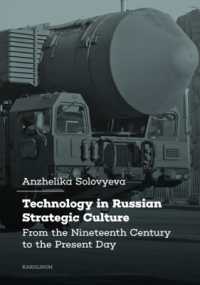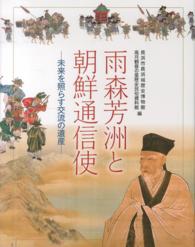- ホーム
- > 洋書
- > 英文書
- > History / World
Full Description
Aristocratic dynasties have long been regarded as fundamental to the development of early modern society and government. Yet recent work by political historians has increasingly questioned the dominant role of ruling families in state formation, underlining instead the continued importance and independence of individuals. In order to take a fresh look at the subject, this volume provides a broad discussion on the formation of dynastic identities in relationship to the lineage's own history, other families within the social elite, and the ruling dynasty. Individual chapters consider the dynastic identity of a wide range of European aristocratic families including the CroÃs, Arenbergs and Nassaus from the Netherlands; the Guises-Lorraine of France; the Sandoval-Lerma in Spain; the Farnese in Italy; together with other lineages from Ireland, Sweden and the Austrian Habsburg monarchy. Tied in with this broad international focus, the volume addressed a variety of related themes, including the expression of ambitions and aspirations through family history; the social and cultural means employed to enhance status; the legal, religious and political attitude toward sovereigns; the role of women in the formation and reproduction of (composite) dynastic identities; and the transition of aristocratic dynasties to royal dynasties. In so doing the collection provides a platform for looking again at dynastic identity in early modern Europe, and reveals how it was a compound of political, religious, social, cultural, historical and individual attitudes.
Contents
Avant-propos, Duc d' Arenberg; Introduction: aristocracy, dynasty and identity in early modern Europe, 1520-1700, Liesbeth Geevers and Mirella Marini. Part I Identity, Ethnicity and Monarchy: Aristocratic identity formation in 17th-century Ireland, Jane Ohlmeyer; The newcomer's dilemma: Henry IV of France and James I of England, Ronald G. Asch; Dynasty and elites: from early modern Europe to late imperial China, Jeroen Duindam. Part II Identity Formation and Family Relations: The Chièvres legacy, the Croÿ family and litigation in Paris. Dynastic identities between the Low Countries and France (1519-1559), Violet Soen; From Arenberg to Aarschot and back again: female inheritance and the disputed 'merger' of two aristocratic identities, Mirella Marini; Points of transferral: Mademoiselle de Guise's will and the transferability of dynastic identity, Jonathan Spangler. Part III Manufacturing Identity: The fruits of war: the representation of Alessandro Farnese in Paolo Rinaldi's Liber Relationum, Sebastiaan Derks; To give to airy nothing a local habitation and a name: creating two great Swedish noble families, Fabian Persson; The Nassau orphans. the disputed legacy of William of Orange and the construction of the Prince of Orange (1584-1675), Liesbeth Geevers; Conclusion: 'The line of descent of nobles is from the blood of kings': reflections on dynastic identity, Hamish Scott. Bibliography; Index.






